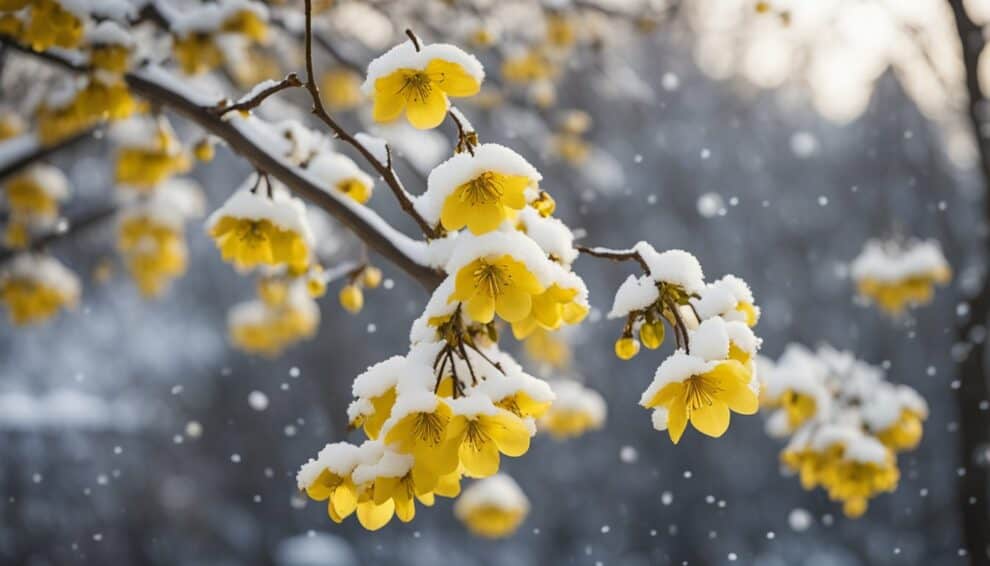Winter can be a dull and gloomy season, but that doesn’t mean your garden has to be the same.
Chimonanthus praecox, commonly known as wintersweet or Japanese allspice, is a deciduous shrub that blooms in the midst of winter.
Its fragrant, spidery flowers in shades of cream and yellow add color and fragrance to the winter landscape.
In this article, we will discuss how to care for Chimonanthus praecox, so you can enjoy its winter blooms to the fullest.

Chimonanthus praecox is native to China and Japan and has been cultivated in gardens for centuries.
It is a hardy shrub that can grow up to 10 feet tall and wide, but can also be pruned to a more manageable size.
The plant blooms on bare branches in late winter or early spring, and its flowers can last for several weeks.
While it is relatively easy to care for, there are a few things to keep in mind to ensure its health and beauty.
Understanding Chimonanthus Praecox
Origins and Characteristics
Chimonanthus Praecox, commonly known as Wintersweet, is a deciduous shrub that belongs to the Calycanthaceae family.
It is native to China and was introduced to Europe in the 18th century. The shrub can grow up to 10 feet tall and wide and has a rounded shape.
The leaves of Chimonanthus Praecox are light green and oval-shaped, with a length of about 4 inches. The bark of the shrub is grayish-brown and smooth.
The flowers are the main attraction of the plant, with a sweet, spicy fragrance.
The flowers are pale yellow, waxy, and star-shaped, with a diameter of about 1 inch.
Winter Blooming Cycle
Chimonanthus Praecox is known for its winter blooms, which appear on the bare branches of the shrub.
The blooming period starts in late January and lasts until March. The flowers are produced in clusters, and each flower lasts for about a week.
The shrub requires a cold winter to bloom properly, and it is hardy in USDA zones 7-9.
It prefers well-drained soil and partial shade, although it can tolerate full sun.
Pruning should be done after the blooming period to encourage new growth and maintain the shape of the shrub.
In conclusion, Chimonanthus Praecox is a beautiful and fragrant shrub that can add color and interest to your winter garden.
With proper care and attention, you can enjoy its blooms for many years to come.
Planting and Initial Care

Choosing the Right Location
When planting Chimonanthus praecox, it is important to choose the right location.
This plant prefers a sunny or partially shaded spot with well-draining soil.
It can tolerate a range of soil types, but it prefers a slightly acidic soil pH.
It is also important to consider the plant’s mature size when choosing a location.
Chimonanthus praecox can grow up to 10 feet tall and wide, so it needs plenty of space to spread out.
Soil Preparation and Planting Tips
Before planting, prepare the soil by digging a hole that is twice as wide and deep as the plant’s root ball.
Mix some compost or aged manure into the soil to improve its fertility and drainage.
When planting, place the root ball in the center of the hole and backfill with soil, making sure to tamp it down firmly.
Water the plant thoroughly after planting to help settle the soil.
To promote healthy growth, apply a layer of mulch around the base of the plant. This will help to retain moisture in the soil and suppress weeds.
During the first year, it is important to water Chimonanthus praecox regularly, especially during dry spells.
Fertilize the plant with a balanced fertilizer in the spring and summer to encourage healthy growth.
By following these planting and initial care tips, you can ensure that your Chimonanthus praecox will thrive and produce beautiful winter blooms.
Ongoing Maintenance and Care

Watering Requirements
Chimonanthus Praecox is a drought-tolerant plant, but it still needs regular watering to thrive.
During the winter months, when the plant is in bloom, it should be watered once a week. Make sure the soil is moist, but not waterlogged.
In the summer months, reduce watering to once every two weeks.
Pruning and Training
Pruning is essential for the health and appearance of Chimonanthus Praecox.
It should be pruned immediately after flowering to promote bushy growth and prevent the plant from becoming too leggy.
Remove any dead or damaged wood, and cut back any branches that are growing in the wrong direction.
The plant can also be trained into a specific shape or size by pruning.
Fertilizing and Mulching
Chimonanthus Praecox does not require frequent fertilization, but it can benefit from a light application of fertilizer in the spring.
Use a balanced fertilizer, such as a 10-10-10, and apply according to the instructions on the package.
Mulching can also help to retain moisture and suppress weeds around the base of the plant.
Apply a layer of organic mulch, such as shredded bark or leaves, in the spring and fall.
By following these simple ongoing maintenance and care tips, Chimonanthus Praecox can continue to thrive and provide beautiful winter blooms year after year.
Frequently Asked Questions

What are the best conditions for growing Chimonanthus praecox?
Chimonanthus praecox grows best in a location with full sun to partial shade and well-drained soil.
It can tolerate a range of soil types, but prefers slightly acidic soil.
It is also important to protect the plant from strong winds, as they can damage the delicate branches.
How do I propagate Chimonanthus praecox from cuttings?
The best time to take cuttings is in late spring or early summer. Choose a healthy stem that is about 8 inches long and remove the lower leaves.
Dip the cut end in rooting hormone and plant it in a pot filled with a mix of sand and peat moss.
Keep the soil moist and place the pot in a warm, bright location. The cutting should root within 6-8 weeks.
What does the wintersweet flower symbolize?
The wintersweet flower symbolizes joy, love, and hope.
It is often used in traditional Chinese and Japanese New Year celebrations as a symbol of good luck and prosperity.
Why isn’t my wintersweet plant flowering?
Wintersweet plants can take several years to mature and begin flowering. If your plant is not flowering, it may be too young or not getting enough sunlight.
Make sure the plant is in a location with full sun to partial shade and consider adding fertilizer to encourage growth.
Which hardiness zones are suitable for growing wintersweet?
Wintersweet is hardy in zones 7-9, but can also be grown in zone 6 with protection from cold winter winds.
In colder zones, it can be grown as a container plant that is brought indoors during the winter months.
How quickly does a wintersweet tree grow?
Wintersweet trees can grow up to 15 feet tall and 10 feet wide, but they are slow-growing and can take 5-10 years to reach their full size.
With proper care and maintenance, however, they can live for many decades and provide beautiful winter blooms year after year.














